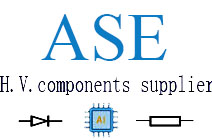How can you check a high voltage diode?
High voltage diodes cannot be accurately tested with the diode test function of a DMM. Basically a high voltage diode is comprised of several lower voltage diodes placed in series, to increase the operating voltage. Since they are in series, you won’t be able to see the 0.6 volt forward voltage as you would in a conventional single diode test on a DMM. So, we need to find another way to test the diode.
For this you will need a variable power supply with adjustable current limiting (any typical bench supply, such as a 0-24 volt would test most high voltage diodes).
For the first step, we are going to try and forward bias, or turn on the diode in question. On your power supply, the first thing you will want to do is set the current limiting to 100mA (remember this is a 500mA diode and we want to be less than that amount). Next, turn the voltage all the way down on the power supply. Hook up the diode as shown in the diagram below. Place the meter to show the current if the power supply only has one display. Now, slowly turn up the voltage while watching the current draw. If the diode is good, at some point you will see the current rise to 100mA and stay at that value (the current limiting has activated on the power supply). Right at the point the current limits to 100mA, the diode is forward conducting or turned on. Depending on the voltage rating of the diode, the power supply will be showing something on the order of 6 volts, 12 volts, or more. If you happen to have a current draw immediately when you hook up the diode (power supply will basically be at zero volts as you try to increase the supply voltage), it is probably shorted.
Next, we’ll just check the reverse bias condition of the diode. Turn the voltage back down on the power supply. Now “flip” how the diode is hooked up to the leads. Again, slowly raise the voltage on the power supply. This time you should not see any current draw on the power supply as you raise the voltage all the way up to the maximum amount. This indicates the diode is not showing any leakage in the reverse bias condition.
This makes a quick and easy test on most high voltage diodes, and you don’t need any special equipment to accomplish this. Just remember to limit the current to the diode accordingly when you do this test.
For more information, PLEASE visits our Web site: www.tomdiode.com
Latest News
Latest News
Contact Us

Global Marketing: Sales team
E-mail: [email protected]
E-mail: [email protected]
Skype: tomdiode













 Skype Chat
Skype Chat Mail inquiry
Mail inquiry